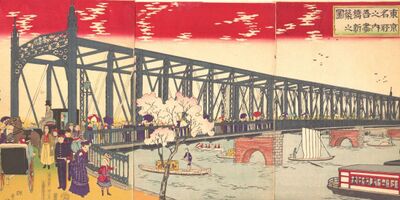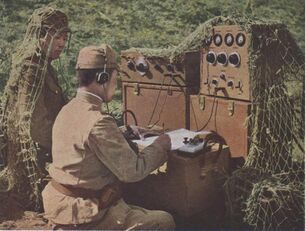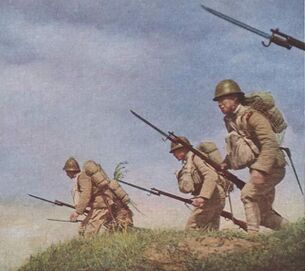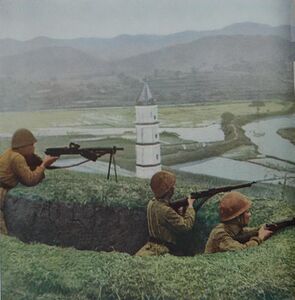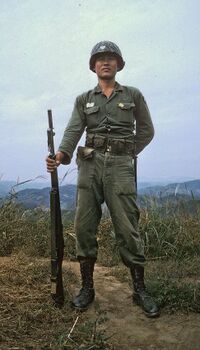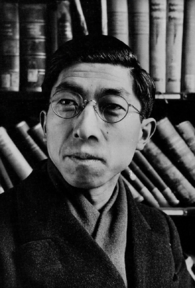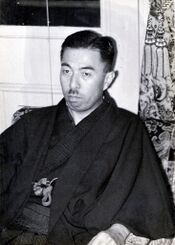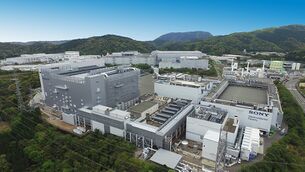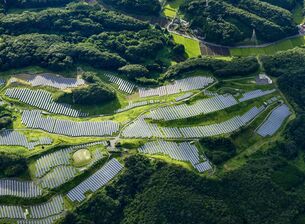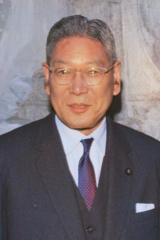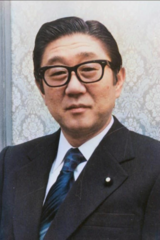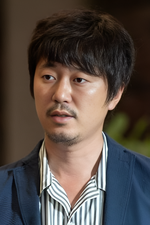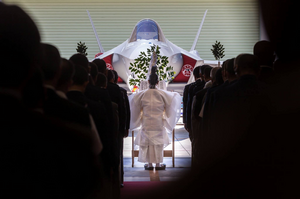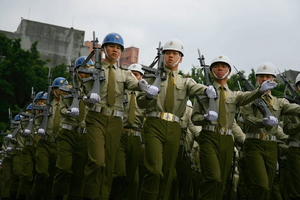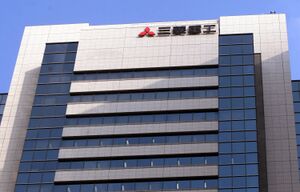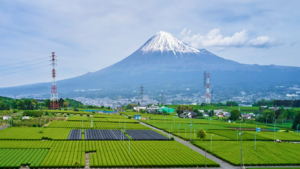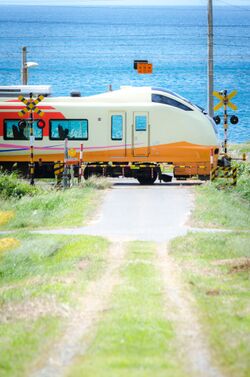Ilbon
Republic of Ilbon イルボン共和国 (Irubon Kyōwakoku) | |
|---|---|
| Motto: 一つの旗の下にすべての民族を! All peoples under one banner! | |
| Anthem: 調和歌 (Chōwa Uta) Melody of Harmony | |
| State Seal | |
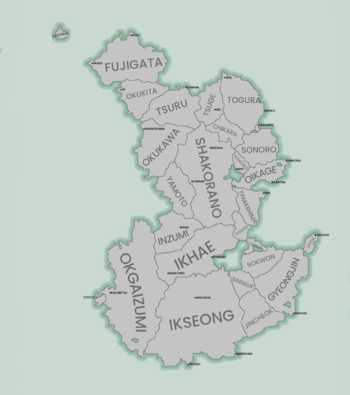 Prefectural Map of Ilbon | |
| Capital and largest city | Oikage |
| Official languages | Ilbon-eo |
| Recognised national languages | Kokuri-eo Kita-eo Inma-eo Pone-eo |
| Demonym(s) | Ilbonese (ethnic) Ilbonese (citizen) |
| Government | Federal Semi-Presidential Republic |
| Kuse Shig | |
| Oszawa Mitsuo | |
| Legislature | Kokkai |
| Establishment | |
• The First Kingdom | 551 CE |
• Domain | 1485 CE |
• Federal Republic | 1815 CE |
• Socialist Peoples Republic | 1910 CE |
• Kingdom | 1939 CE |
• Republic | 1996 CE |
| Population | |
• 2020 estimate | |
• 2022 census | |
| GDP (PPP) | 2022 estimate |
• Per capita | 52,128 $ |
| GDP (nominal) | 2022 estimate |
• Total | 10.5 Trillion $ |
| Gini (2022) | 0.391 low |
| HDI (2022) | 0.925 very high |
| Currency | Yen (YYN) |
| Date format | dd.mm.yyyy |
| Driving side | left |
| ISO 3166 code | DR |
| Internet TLD | .dr |
Ilbon (Ilbonese:イルボン, Ielbon or Irubon, officially known as the Republic of Ilbon, and formally Irubonkoku) is an island nation in Agleia . It is situated to the east of Agleia and Sorenwey. Ilbon has no natural land borders no neighboring states; it does share territorial waters with other nations. Ilbon is surrounded on all sides by smaller island chains, with there being nearly 4,000 smaller islands surrounding the nation on all sides. It claims parts of modern Todavil-Nadu. Oikage is the nations largest city and capitol, followed by Osaga, Kokasa, Mie, Niinoshima, and Ar.
Ilbon is the 8th most populous country in the world, and is one of the most densely populated countries in the world. Its most populous city is Oikage home to nearly 20 million people and is so large that it has become its own prefecture, it is the largest urban metropolitan region in the world. Most of the primarily tropical nation's terrain is hilly or flat, with the nations only mountain range being located along the western coast of the island. Ilbon is divided into 11 regions, which are then further divided up into 22 prefectures and 3 Federal Cities
Etymology
The name "Ilbon" comes from the combination of two ancient Ilbonese words: "Il" meaning storm, and "Bon" meaning land. Ilbon, due to its geographic positioning, has historically been battered by all kinds of storms, whether they be typhoons or snowstorms. The sheer amount of stormy weather experienced by Ilbon throughout its history has had a profound effect on how the nation's people viewed weather and the seas before the development of proper meteorological methods, leading to the superstitious level of fear and admiration that some parts of Ilbonese society have towards the weather.
History
Ilbo-Genesis
The first humans to arrive in Ilbon did so around 10,000 years ago when they migrated from Sorenwey to Ilbon on small wooden vessels in waves and established a primitive hunter-gatherer, pit-dwelling culture on the island. The first wave of arrivals, which later went on to form the Kita-Tomin culture, was eventually pushed out by the second wave which was that of the ancestors of modern middle Ilbonese "Ruuzoji" people, who were later pushed out by the ancestors of the Kokuri who arrived with the third wave of settlers. Based on cave paintings and primitive inscriptions found in the mountainous regions of western Ilbon, it is assumed that early Ilbonese settlers from all 3 cultures drifted towards figures of authority and based their tribal structure around obeying these figures of authority. Early Ilbonites have been, due to the lack of found damage on ancient skeletons, theorized to have been pacifistic by nature, only resorting to combat when all other options were exhausted by their surroundings.
First Kingdoms
Ilbon's first unified kingdom came about during the 4th century BCE and was led by King Tsuchiya Mayumi and his council of warriors. Before he consolidated power in the lands of middle Ilbon, King Mayumi led a smaller tribe of warrior-gatherers named the "Omuras" or "growers", who slowly absorbed their neighboring tribes via peaceful annexation over the span of two decades to eventually form the first Ruuzoji Kingdom; every legitimate and illegitimate emperor after Mayumi's death would claim to be descended from the Tsuchiya and Omura clans. After King Mayumi consolidated control in the 4th century BCE, he declared himself to be the King of the Ruuzoji and took it upon himself to begin expanding the kingdom's military and scientific skill, reaching out to prominent intellectuals from across his Kingdom such as the mountain-dwelling Sugihara Moriko and his group of apprentices, and personally training soldiers to bolster the military's strength. Mayumi, during his reign as king, was rumored to have been a homosexual because of his inability to produce a male heir, but eventually married one of his female concubines and produced a male heir the year after. King Mayumi is viewed as an almost divine figure to followers of the Imperial family, and his founding of the Ruuzoji Kingdom has become an almost mythical event in Ilbonese history.
Mayumi reigned as king until the age of 50 and left his kingdom to his younger son, Tsuchiya Tsutsomu. Tsutsomu, led by his father's council of warriors, ruled much in the same way as his father did but made many more attempts at encroaching upon the territories of the Kita-Tomin and Kokkuri. At the age of 31, Tsutsomu was shot in the shoulder by an arrow from a Kokkuri assassin, which prompted a retaliatory strike from the Ruuzoji army, leading to the beginning of the first Ruuzoji-Kokuri war. The Kokkuri, although largely outnumbered by the Ruuzoji, were noted to have fought with "stunning tenacity", and many captured Kokkuri warriors were even sent back home to the houses of Ruuzoji noble families to serve as bodyguards and mercenaries. After 8 months of inconsistent fighting, King Tsutsomu of the Ruuzoji people and King Beon of Kokkuri met atop hill Haneul in what is now the region of Izumi to negotiate an end to the war. The terms agreed upon were deemed to be fair to both sides, and the two kings left satisfied by the negotiation, but not before reportedly bowing to each other in a show of "ancestral respect". Haneul hill was declared an ancestral site by the Ilbonese government in 1977 for demonstrating the connection shared by the Kokkuri and Ruuzoji peoples.
Ruuzoji Civil War
Centuries of Strife
Auspicious Revolution
In 1825, the Ruuzoji domain's rapidly deteriorating stability became apparent to Ruuzoji’s across its lands. Secret societies were formed, cliques in the military began to scheme, and many many other sects of Ruuzoji society saw an opportunity to put their beliefs and ideologies into power. Armed men stormed public offices, police stations, and even the imperial court; the army mobilized and marched straight towards the imperial capital in Iwigi, storming it and capturing the emperor. Although the emperor was far from a beloved public figure, the revolutionaries deemed that it was far too great a risk to execute him, instead preferring to strip him and his family of their titles and integrate them into civilian society. The Domain's new government was extremely chaotic due to the continued presence of the military, as well as other revolutionary groups in the still recovering Domain. Once the dust settled, the republican Revolutionaries of Oikage triumphed and became the founders of the new “Ruuzoji Federal Republic”, a Federal Democratic Republic.
Reform after reform was passed by the new republic as it went about tearing down the old and archaic structures of the previous imperial dynasty: suffrage was granted to all male Ruuzoji and high-class women, and a legislative assembly modeled off the Imperial Court of Emperor Okabe was created. At this point, gunpowder weaponry and technologies of the industrial era had already been in use by the Ruuzoji, Kokuri, and Kita-Tomins, but the Ruuzoji were considered the first of the three sister-peoples to have put large parts of the newly created Republic's budget was put towards funding the continued research of modern technologies to put into use in fully industrializing Ruuzoji and bringing up to pace with the rest of the world. Land reform was inacted and excess land was taken away from the large feudal lords and distributed back to smaller peasants and landholders to encourage efficiant usage of land during the nations state-enforced industrialization. Governmental roles were handed out based on merit instead of social standing like how they had been during the imperial era. Although the government was officially a republic, the president officially didn’t have term limits and could serve for as long as he wished; this issue was debated constantly by the members of the Ruuzoji diet but was never truly solved, only being remedied by unpopular bills and acts. The lack of term limits led to the first president simply refusing to resign and to accept the diet's ultimatums in 1832, resulting in the degradation of Ruuzoji democracy and the formation of an oligarchy in the place of what was supposed to be a free, representative democracy. This same oligarchical class would hold power in Ilbon until the Red Admiral's Coup in 1901.
Machinist Era
With the Oligarchy's grip over Ruuzoji politics secured, their chosen president, Tsutsui Yuu, working off orders given to him by members of the Council of Military Affairs, began preparing the Ruuzoji Federal Republic for its first military actions since the days of Empress Hitomi and the Lotus Sun Society. The Ruuzoji Republican Army grew from 150,000 troops equipped with decades-old muskets in 1835 to a force of 450,000 troops equipped with modern rifles and cannons in 1851. Accompanying the Ruuzoji military's quickened growth was an increase in the size of Ruuzoji cities, as trends similar to the industrialized societies of Maris were beginning to be observed in Ruuzoji cities: farmers, fishermen, and other "pre-Republican" professions were being slowly phased out in favor of city-dwelling, factory-based work, and wage labor. Most impressive to foreign observers and the statesmen of the Republic was the rapid growth of the city of Oikage, where the capitol was soon moved to after the old capitol, Iwiki, was deemed unfit to be the center of government. The first School of Economics in Oikage to study and map the pace of Ruuzoji's economic growth, and it was found that the economic health of the country had greatly increased since the days of the last Ruuzoji emperor. Following the establishment of the first School of Economics, the National Planning Bureau was established to help coordinate with Ruuzoji industrialists but didn't receive enough attention from the leading Oligarchs to begin its operations. While Ruuzoji industrialization was still in its early stages, cliques of businessmen began to take advantage of the profitability of Ruuzoji industrialization, and formed the first Ruuzoji corporations; the small ore refinement company "Kaga Hagane"(literally, Kaga Steel), being a prime example of a small business that took advantage of the Ruuzoji industrialization. Many other companies and corporations would form out of the implementation of free-market policies in the Republic, but only some would survive the wave of nationalizations that followed the Red Admiral's Coup in 1901.
Industrialization, despite the positive effect it had on the strength of the Ruuzoji Republic and its military, hurt the livelihood of Ruuzoji citizens, especially those who lived in the newly industrialized cities. Dwellings were typically small and could only fit 2-3 people, and those who couldn't afford dwellings were forced to sleep in small community sleeping lodges which cost them a small amount of money on an hourly basis. Large smokestacks from nearby factories spewed thick clouds of smoke which blanketed the sky for miles; some clouds of smoke went as far as the western mountains before finally dissipating. The factories themselves were worked and manned by poorly paid migrants from the rural prefectures of the republic and were considered places of "utmost indignity" by farmers. Conditions in the factories were considered appalling to most and began to be slowly improved by the cabinet of President Fukunaga after the enactment of the National Labor Standards and Fair Treatment Edict in 1873. The sprawl and filth of the cities were contrasted by the wealth and splendor of the Neo-Urban city outskirts, where the wealthy members of Ruuzoji society hosted lavish parties and balls for themselves and their neighbors.
In the year 1855, the Republic was deemed "sufficiently industrialized" by then President Iwai and began making aggressive moves towards its neighbors in the north, the Kita-Tomins. The Kita had industrialized at a slower pace than the Ruuzoji and were the first target of Ruuzoji expansion. A border skirmish followed at the Kita-Ruuzoji border. On May 15th, 1856, Ruuzoji skirmishers began an assault on the small Kita outpost, "Castle Abai", seeking to lure out the fort's small 5,000-strong army of defenders out from their advantageous position. The Kita never left the fort and were instead assaulted by a larger Ruuzoji force numbering 9,000. The siege of Castle Abai lasted only 3 days and was the first battle of the coming Kita-Ruuzoji War. The war lasted 3 months and the Kita were forcefully annexed into the Ruuzoji Republic, forming the Kita-Ruuzo Federal Republic. In the coming years, the KRFR began preparing for war with the Kokuri Beon Kingdom by expanding its policies of mass industrialization and modernization to the conquered Kita lands.
With the coming of the 1870s, the KRFR was ready for an invasion of the Beon Kingdom but needed a justification to do so, especially considering that the Kingdom was supported by Essone. On October 25th, 1872, an explosion in Oikage harbor was blamed on the presence of a Kokuri merchant ship, giving the Ruuzoji the casus-belli it needed to launch a full-scale invasion of the Beon Kingdom. The ensuing war would be the first and last major land war to happen on the Isle of Ilbon. It was also the first time in Ilbons history that two fully-industrialized armies clashed with the support of modern weapons and mass production. The Kokuri-Ruuzoji war lasted 8 years and claimed the lives of nearly 900,000 people in total, and resulted in the annexation of the Beon Kingdom into the Ruuzoji Republic, making it the first time in Ilbons history where a single nation managed to unite the entire island. Essone, having lost their only ally on the Isle of Ilbon, launched an invasion of the newly unified Republic from the northern tip of the isle, but were pushed back into the sea after Ilbonese troops launched a counter-attack; Ilbon's victory in the war against Essone is still a point of national pride in the modern day.
Revolution and Red Ilbon
The 1880s for the newly unified Ilbonese Federal Republic are remembered as times of great trouble for the island, as the prosperity of the previous decades began to subside. Corporate dominance in the economy was nearly unmatched, workers across the nation, despite having seen a general rise in living standards, still worked long hours in factories for meager pay, and the Oligarch's grip on Ilbonese politics was still uncontested. The war with Essone had created tensions between Ilbon and Maris, making trade difficult to establish and affecting the well-being of the Ilbonese economy. Left-wing political movements became popular in the cities and began to trouble industrialists, who beiged the military to hunt down socialists, anarchists, and communists; this culminated in the start of the first Ilbonese Red Scare. Political instability caused by mass repression, combined with economic downturn, led to the collapse of the long-standing Oligarchy in 1901 at the hands of Admiral Orio Bunko and his socialist officers.
During the early 1900s, the newly proclaimed Socialist Peoples Republic of Ilbon, fought with both reactionaries that took advantage of the instability following the Red Admiral's Coup, and remnants of the old Oligarchical government. Also, separatists from the Kita and Kokkuri regions revolted against the Ruuzoji to establish their own independent states. The Red Admirals went into negotiations with socialists in the two aforementioned regions and created a pact of mutual cooperation; this pact is considered one of the first examples of a "Pan-Ilbonese identity" being created on the island. Republican as well as reactionary revolts were put down in a period of Red Terror called "Crimson Autumn". A full-blown civil war was prevented after the assassination of Okabe Yuki, a prominent leader in the reactionary resistance, and the exile of the last remaining Oligarchs. True authority still rested in the hands of the military, but responsibilities were slowly being returned to the people, and the military began loosening its grip over Ilbon as well as wrapping up the Red Terror.
Admiral Bunko stepped down in 1905 to allow a civilian government to form, giving rise to the Zen Irubon Jinmin Tō, or "All-Ilbonese Peoples Party". The AIPP, under the leadership of Seo Yuu, became Ilbon's dominant political party. Premier Yuu, prior to the founding of the SPRI, was an outspoken nationalist, as well as a labor organizer and member of the military, earning him respect from both left-wing and right-wing groups. The AIPP's official ideology was "National-Vanguardism", a unique mixture of revolutionary Socialism, Pan-Ilbonese nationalism, and radical modernism. Most major industries were nationalized and smaller businesses were either completely integrated into Bureau of Economic Management or turned into "state-owned enterprises" for the government to use in its future economic plans. Alongside this, old traditions that were deemed too conservative by the standards of the new government were abolished or reframed to fit the SPRI's egalitarian agenda. The National Vanguardists sponsored artists, poets, and philosophers much in the same way that Emperor Okabe had in the 14th century. Admiral Bunko's military philosophies became the official national school of thought for reforming and strengthening the military. The Ilbonese army began producing its own tanks and airplanes, enforcing strict discipline, creating a meritocratic structure of organization, rooting out corruption in its ranks, and creating plans to fight future wars.
During the 1920's the old imperial family, which had now just become another collection of nobles, was invited to join the socialist government, upsetting anti-monarchist organizations. The nobles declined the offer, and in January 1924, the Socialists acted against the old imperial family and attempted to capture them all in one fell swoop, but were stopped by the "Imperial Restoration Association", a small army of rebel military officers and soldiers who wanted to preserve imperial traditions in Ilbon. Most of the IRA's leaders were raised in destitute areas of the Ilbonese countryside and were utterly disgusted by the unmatched wealth and power that the affluent Socialist elites had in the country. The IRA showed up with 5,000 men, blocked the Ilbonese National Army from entering the Imperial Palace, and negotiated with the Socialist government for the peaceful exile of the Imperial family. For 6 days, the IRA escorted the Imperial family through the plains of northern Ilbon until they were eventually able to board a boat from Ilbon to Eushima, then from Eushima to Nuwea; they would not return until the reformation of the Ilbonese Kingdom in 1940. The removal of the Ruuzoji royal family was seen as a final triumph of Socialist ideology in Ilbon.
On September 1st, 1930, Seo Yuu passed away from health complications and his sucessor, Nagano Toru, was appointed the new prime minister. Toru was already a controversial figure in the AIPP for his ultra-nationalism and pushes to wage a "peoples war" against neighboring states, especially Elesthra and Artadesia. Additionally, he was known for making chauvinistic jabs at his Kokuri and Kita party members. Nagano's first actions as premier were to begin militarizing the state, as well as inviting back nationalists who had been expelled from Ilbon during the Crimson Autumn. Businesses once nationalized were given more autonomy and turned into "Peoples Conglomerates"; these Conglomerates went on to become the "Big Nine", the group of state administered corporations that dominate half of the modern Ilbonese economy. His actions caused alarm across eastern Agleia, and eventually led Ilbon to fight in the Second Great Cellian War. Discontent began brewing in the largely reformist military and lasted until the end of the war, in the end it resulted in the collapse of the SPRI.
Second Great War and the Deluge
During the Second Great War, Ilbon fought wars across Elesthra and Artadesia. Ilbon itself had tenuous relations with other Socialist powers and more or less fought to achieve what it saw as the liberation of Agleia and Sorenway. Before the onset of the war, Ilbon had spent many decades building a large modern fleet to project its power abroad. This same fleet, much like the army, saw combat in the seas and oceans surrounding the island. The Nagano Toru further secured his dictatorial grip over the nation as the war progressed, side-lining many of the internal factions that he had worked with some years ago to achieve power. The new premier, along with a clade of corporate technocrats, established complete control over Ilbon near the climax of the Second Great War. Ilbon managed to hold onto its conquests during the war and even expanded into nations beyond Elesthra. But Ilbons success was short-lived because in 1939, a massive meteor slammed into the !Pacific Ocean; this cosmic event would later become known as the Deluge.
The Second Great War came to a close in 1940 and Ilbon was in ruins. Massive waves from the !Pacific Ocean had washed over Ilbon's eastern coast, wiping out the Grand Eastern Navy and putting the Socialist government on edge. Cities were in ruins, refugees were fleeing further and further inland, and political tensions long thought extinguished, returned and began putting more strain on the state. Revolts broke out all over Ilbon, the primary demographic behind them being disaffected workers. Activists and revolutionaries attacked provincial capitals and broke into prefectural armories to resist the government. The army was recalled from its deployments in Elesthra to put down the revolts. In the days, weeks, and months following its redeployment to the Ilbonese home island, the Ilbonese Peoples Army and its associated paramilitaries ended the revolt against the Toru government, bringing state control over regions that were declared to be in "full anarchy" some months before. Even though the revolts may have been put down, the government's ongoing instability was an unavoidable issue, and so the long-reigning Socialist government was replaced by a clique of Junior reformist officers; ending 4 decades of Socialist rule on the island.
Reconstruction and Cesylle
The first major decision made by the Officers Junta was to invite the Ruuzoji Royal Family back to Ilbon. Nishioka Taro, the legitimate successor to the Ruuzoji throne, was shipped back to Ilbon from Nuwea with the remaining soldiers of the Imperial Restoration Association and crowned monarch of the new "Kingdom of Ilbon". Afterwards, the established Military Reconstruction Government began removing remaining insurrectionists from the 1939 revolt and began creating democratic institutions for the impending democratization of the country. The Junta established the "three purposes of the nation": establishing and maintaining the well-being of the people, guaranteeing the right for the people to determine their future through fair electoral practices, and ensuring the continued existence of the Ilbonese race; the Three Purposes were adopted into Ilbons 1941 constitution. Ilbon's new constitution was adopted on September 1st, 1942, ending the Officers Junta and inaugurating Goda Osamu as the nations first democratically elected Prime Minister in almost 80 years.
Osamu invited a broad spectrum of Ilbonese political parties, organizations, and associations into his political coalition. Everything from right-wing groups to pseudo-socialist organizations were invited to the coalition, named the "Grace Front". Osamu wanted to create a "Pan-Ilbonese" coalition that transcended ethnicity, culture, and politics. Osamu also coined the phrase "All peoples under one banner", which became the Kingdom's motto. With the support of most legal Ilbonese organizations at his back, Osamu began implementing his 5-point plan for Ilbon's reconstruction, beginning with the material reconstruction of the country. Old technocrats from the Socialist government were rehabilitated and brought into the government to help organize the reconstruction of Ilbon's economy. First was the re-establishment of different societal institutions, such as education, healthcare, and welfare for the poverty-stricken rural areas of Ilbon along with refugees who had fled further inland during the destruction of Ilbon's eastern cities. Rural schools in Ilbon had been historically destitute but were brought up to speed with the educational standards of the world by 1948. Ilbon's first state welfare program began to distribute monthly payments to eligible citizens. Initiatives to completely modernize Ilbons farms commenced afterward to make up for the state revenue that had been lost during the Deluge; rural modernization was completed in 1949. The issues of economic direction, housing, and diplomacy weren't initially prioritized but eventually began to be developed on in 1946 as Osamu implemented reforms addressing the aforementioned issues. Cities on the countries' mostly devastated eastern coast, like the capital Oikage, were rebuilt but still struggled to return to their former opulence until the latter half of the 20th century. Ilbon incentivized immigration through guarantees of financial stimulus for those coming to the island to ensure future economic and population growth. Osamu did not fully rebuild Ilbon but is still considered to be the primary figure who led Ilbon through reconstruction.
5 years after the deluge, Ilbon once again found itself at war, this time against the Aldlockean Federation, which had started an international crisis by invading its neighbors. Goda Osamu saw a chance to establish friendly diplomatic ties with the nations of Cesylle by providing aid and began preparing troops, supplies, and advisors to be sent overseas to fight the Aldlockean Federation. 200,000 Ilbonese soldiers - some of whom were veterans from the Second Great War and others who were newly trained draftees - were sent east alongside the 2nd Naval Group, which had been stationed on the western coast of Ilbon, protecting it from the Deluge. In combat, Ilbonese troops went toe-to-toe with Cesyllen infantrymen and tanks, the latter often being left unopposed on the battlefield until heavier vehicles were deployed to the battlefield to engage them. Ra Jiwoo spoke to General Secretary Jad Madsen of Druermarsk after the atomic bombing of Olofsby, and adopted more new strategies. Napalm saw continued use and trench warfare returned in some sectors of the front. After a year of fighting, 50,000 Ilbonese soldiers had died in Cesylle and the rest returned home. Returning soldiers were deeply scarred by the experiences they had in Aldlocke; the term "壊れた" (Kowareta or "Broken") has been used to describe this generation of soldiers. Stories, novels, manuscripts, and autobiographies written and shared by the veterans of the war in Aldlocke would soon proliferate across the Kingdom in the coming years and eventually helped to form the basis for Ilbonese foreign policy in the coming decades.
Return to the World Stage
Goda Osamu announced the dissolution of the Grace Front in 1951 along with his resignation as Prime Minister. The organizations that made up the Grace Front organized into new parties and independent coalitions along ideological lines. Ilbon's first General Election was held in April, 1952, and resulted in the victory of Wi Dong-Yul and the Ilbon Renovation Society, a Progressive-Conservative organization. During reconstruction, Dong-Yul served as an ambassador to both Elaklania and Nastanovo, establishing ties with the two Cesyllen nations. He also served as a diplomatic advisor to Goda Osamu. Dong-Yul's primary focus was rebuilding Ilbon's eastern cities and building strong diplomatic ties with anti-communist nations across the world. The Prime Minister was a guest at the creation of the Defense Treaty of Independent Nations and met with Nuwean diplomats on Eushima to found the Eushima Pact, the long-standing Ilbonese-Nuwean alliance. Ilbon also joined the International Assembly with the Prime Minister personally attending every session as Ilbons official representative to the Assembly. Domestically, Wi Dong-Yul championed equality among the three ethnicities that made up the home islands and pushed for the creation of a shared Ilbonese culture. Dong-Yul himself was a Ruuzoji but lived in a Kokkuri Prefecture, had many Ruuzoji and Kita associates, and also served in the cultural ministry of the Socialist Peoples Republic some decades prior. Economic regulations put in place during reconstruction became less and less prominent and laissez-faire attitudes dominated economic thinking. In 1953, communist protests erupted in Ilbon over the governments inaction in settling labor disputes, these protests were put down but did significant damage to Dong-Yul's reputation. Despite this, Dong-Yul was able to win re-election in the 1956 General Election.
Dong-Yul's second term primarily focused on ensuring the changes made during his first term were kept in place and centralizing Ilbonese prefectures around the government in Oikage. Ilbon's constitution was amended to make Ilbon into a federal state, where the prefectures retained generous autonomy; fears of ethnic separatism and revolts were the main forces behind the revisions. Around this time, the formation of new leftist parties accelerated and a determined left-wing opposition to the Renovation Society formed in the Kokkai. The leader of the opposition, Tsuda Hiroshi, had built a strong base of support among the workers and petite-bourgeois of Ilbon's eastern cities, as well as immigrants who had arrived in recent years. Ilbon now had three major parties in the Kokkai: The Renovation Society, the United Labor Front, and the Shin-Ken Peoples League. Dong-Yul built support among monarchists and farmers, while Hiroshi courted republicans and industrial workers. The 1960 General Election was among Ilbon's most contested. The United Labor Front won a slim majority, beating Wi Dong-Yul's renovation society. Following their defeat, the Renovation Society split up into various smaller factions, and Dong-Yul himself stepped away from politics after conceding to Hiroshi. Under Dong-Yul's administration, Ilbon had established itself as a major regional power and formed ties with other nations across the world. He is also the man who set up the framework for Ilbon's corporate economy, although this is still debated by historians.
Rise of Labor
Idle Era
The Carp Years
Faltering support for the Ilbon Liberal Bloc before the 1972 general election gave oppositional parties in the Kokkai a chance to usurp the majority the ILB had held for the past 9 years. Out of this opportunity came politicians like Amano Katsuro, the mayor of Minna. His party, "Forwards Fatherland", was until the year 1972 a minor party in the Kokkai and did not hold much influence outside of Inkseong Prefecture and the city of Minna, but did see some growth following the unsuccessful economic reforms and ensuing impeachment of Prime Minister Ose Hachiro. Katsuro used popular anger against the former prime minister in his speeches and promised to move past the disastrous economic policies of the Liberal Government. On top of this, Amano Katsuro promised to fix Ilbon's economic problems and further integrate it into the global community. Most Ilbonese political scientists agree that Amano Katsuro was a centrist and chose to keep his beliefs vague to appeal to as many people as possible, but Katsuro's proclivities towards authoritarianism and centralism are not questioned. Katsuro's supporter base, before his 1972 election campaign, consisted mostly of workers and farmers from Minna and its surrounding towns, but after Katsuro announced his bid for Prime Minister in 1971, a wider range of people put their support behind his campaign. Kokkuri and Kita representation groups also put their support behind Katsuro. On July 18th, 1972, Amano Katsuro was declared the winner of the 1972 Ilbonese General Election and inaugurated as Prime Minister two weeks later.
After securing a comfortable majority in the Kokkai, using marginal cooperation with the United Labor Front, Katsuro's administration went on to start fixing the problems that the previous Prime Minister hadn't been able to. The new Prime Minister promised the abolishment of "Want, Disease, Ignorance, Squalor and Idleness". Katsuro appointed Eguichi Kazuhiro, an infamous economist from Oikage, and Matsuzaki Toshiaki, an up-and-coming diplomat, to key positions in his government and gave them the leverege they needed to get changes implemented with minimal intervention from the Kokkai. Among the first reforms passed was the Ilbon Basic Needs Act in 1973. This created a range of state programs that provided additional income to low and middle-income families to help maintain financial stability. Food and clean water were also declared "basic needs" by the 1973 act, causing the central government to subsidize farms in exchange for growing more food at lowered prices. Access to clean water and proper plumbing was expanded across the nation and in 1992, near the end of Katsuro's 3rd term as Prime Minister, 98% of homes in Ilbon had unimpeded access to clean water and were connected to the national sewage system. Primary and Secondary education had been free in Ilbon up until this point, but tertiary education was meant to be paid for. Using the advice of Kazuhiro, the State Education Amendment was passed in 1975 and made all education in Ilbon free, from the start of primary schooling to the end of tertiary schooling. Instead of receiving funding from private institutions, Ilbonese universities would be funded directly by the central government in exchange for letting all students attend at minimal cost to no cost. In the following months, the National Healthcare Plan was created as the foundation for Ilbon's modern healthcare system. Billions were funneled into the healthcare plan, and by the end of the 1980s, Ilbon's healthcare system was up to modern standards. Katsuro's public approval soared from 46% in 1974 to 71% in 1976, allowing Forwards Fatherland to win the 1976 General Election in a landslide.
Katsuro's next 4 years in office were dedicated to solving economic shortcomings. Ilbonese industry had been neglected for at least a decade, previous Prime Ministers put more faith into the nation's growing electronics market than in the nation's industrial capacity that Ilbon was known for in the past, causing much of what was once productive industry to rust. In addition to this, trade ties with the rest of the world were strained and Ilbon's internal markets were slowly becoming less varied, causing a small depression. Minister of Economic and Fiscal Health, Eguchi Kazuhiro, proposed a 10-year economic plan and the "Ilbon Industrial Development Ordinance". The end goal of the 10-year plan was to revitalize Ilbon's dilapidated industry and begin creating a strong and diverse internal market. The IIDO bound the large corporations that monopolized parts of the Ilbonese economy to the state and opened up the nation's markets by replacing Ilbon's ideologically motivated foreign policy with a pragmatic and business-friendly doctrine. Deviation from the anti-communist line set up by Prime Minister Dong-Yul a three decades earlier upset members of the Kokkai, but Katsuro swayed Socialists to his side to pass the IIDO. Matsuzaki Toshiaki was sent abroad over a period of around three months, where the Minister of Foreign Relations flew to dozens of countries in a single trip to improve Ilbon's relationship with the rest of the world, including the member states of the ASL; this was the first time that an Ilbonese diplomat had stepped foot in Druermark since 1910. After six years of the ten-year plan being in effect, Ilbon's industry was modernized and the economy diversified greatly. It kept producing more electronics and began manufacturing luxury and civilian automobiles, household appliances, telecommunications equipment, cell phones, and military equipment among other things. This period of rapid social and economic change became known in post-Katsuro Ilbon as the "Carp Years". In 1983, two more figures would arrive in the Ilbonese political scene, them being Bok Hyun and Oto Hikasa, two corporate executives from an upcoming electronics corporation. After observing the effects of their corporate labor standards in one of their factories, the duo concluded that higher wages, along with a more humane work environment fostered greater productivity among their workers, and came to Katsuro's headquarters in Minna to present their idea to the Prime Minister. Katsuro was impressed, and began drafting a revision of Ilbon's labor laws, but was stopped by the Big Nine. The Prime Minister met with the Executives of the nine corporations in Oikage and came to an agreement where the corporates would gain some autonomy in the new state-guided corporate system that was being built, in exchange for the implementation of the Hyun-Hikasa Labor Revision Ordinance; this meeting between Katsuro and the Big Nine is where his nickname, the "Tiger of Oikage", came from. The last of Katsuro's reforms were passed in 1987, in the form of the Open Ilbon Ordinance, incentivizing immigration to Ilbon and making it simpler. With Ilbon in an improved state, Katsuro retired from office on July 19, 1992, the same day he was inaugurated 2 decades prior. Katsuro is remembered as the "Father of Modern Ilbon" for playing a decisive role in building the nation's modern economy.
Post-Katsuro and the Modern Day
In January, 1994, a series of student protests began in the northern city of Koai, with the total number of active protestors being in the thousands. Police were deployed but failed to quell the protests, which soon turned into full-blown riots, leading to further militarization of police and greater radicalization among protestors. Military police were called in to crush the riots but found that the rioters had turned the streets of Koai into makeshift fortresses and were employing guerilla tactics to fight back against the police. Tanks were deployed to clear the streets, resulting in the end of the riots. 106 rioters had been injured while 6 had been killed, and the police of Koai had lost 3 officers to the mobs.
In March, 1996, Watani Castle came under assault from a group of anarchist militants. Watani Castle, located in the inland city of Mifu was at that time occupied by the Shinju branch of the royal family and administered by the widely beloved Prince Yuka. The militants assaulted the castle in the dead of night, dispatched the castle guards, broke into Prince Yuka's palace, and kidnapped him along with his entire family. The ensuing days were filled with anxiety as security forces attempted to negotiate for the safe release of the Shinju family. Ilbonese television broadcasted the crisis and most of the world saw what was unfolding. The militants had a list of demands, at the top of the list was their safe extradition out of Ilbon. One by one they surrendered the members of the Shinju family, but they refused to let go of Prince Yuka's grandchildren, who were planned to be taken with the militants in their plan to flee Ilbon. Security forces fought to remove the remaining militants by force and began a siege of Watani Castle, but were forced to stop when the militants threatened to kill the remaining hostages. After almost a week of negotiations, the Militants killed the two remaining hostages before committing suicide. The deaths of the two Shinju heirs shocked Ilbon, the shock was felt worldwide; foreign governments gave their condolences to the Shinju family. During the nationwide unrest that followed the tragedy at Watani Castle, a contingent of the Kokkai's members who followed Republican beliefs went into action and amended the constitution through the Kokkai. The new amendment would not only abolish the monarchy but give the provisions necessary to put down the riots. The amendment made it so that the royal family kept their titles but were no longer able to hold any positions of power, it also empowered the Kokkai and the National Police Force. King Taro was sent a draft of the amended constitution and accepted the changes, proclaiming that "he would do whatever the people asked of him, even if it meant stepping down as sovereign of the nation." The Republic of Ilbon was proclaimed three days after in front of the Kokkai and a strong crackdown on rioters began.
Since the King's abdication in 1996, Ilbon's democratic processes have remained in place and elections have continued to be held every 4 years. The Ilbonese Peoples Party, a broad coalition of liberal-republican groups, held power until 2008 when the resurgent United Labor Front managed to defeat them and win a majority in Kokkai. The United Labor Front removed moderate elements of the party in an autocoup and returned the left wing of the party to dominance as it had been during the first two Labor Governments. In 2012, the ULF passed the Marriage Equality Act, legalizing same-sex marriage in Ilbon and codifying marriage equality in the Ilbonese Constitution. Using popular sentiment and fears of a radicalized right-wing party assuming power (namely the National Front), the United Labor Front won the 2016 election in a landslide, increasing its majority in the Kokkai to sizes not seen since the second Labor Government. Using this majority, the ULF has begun transitioning the Ilbonese economy towards a Socialist system by challenging corporate dominance and fracturing the largest corporations into smaller cooperatives. In January 2020, the Kokkai passed the Corporate Restructuring Act into law. It has become by far the most radical attempt to "de-capitalize" the economy to date, forcing all corporate entities to fracture their assets and submit to state control by 2024 or face harsher measures at the hands of Federal authorities. Now, eight national conglomerates have been deconstructed into smaller enterprises or completely subsumed into Federal planning agencies. The United Labor Front won the 2020 General Election by a smaller margin than in 2016, but still retained control over the Kokkai. The months following the 2020 General Election were relatively peaceful, although there was a dramatic increase in crime against immigrants. In February 2021, the Kokkai banned the National Front, arrested its leadership, and began prosecuting higher-ups in the organization. This came after the murder of multiple immigrants at the hands of National Front members. After a small recession, President Takeo and the Kokkai created a robust system of anti-poverty initiatives: targeting rural poverty, creating a system of social dividends, increasing cooperative membership, modernizing infrastructure, and increasing access to digital resources were the primary objectives of these initiatives.
Politics
Governance
Administrative divisions
Largest cities
Foreign relations
Ilbon maintains a pragmatic foreign policy for the purpose of keeping trade relations with as many nations as possible as well as keeping itself safe from war. Ilbon maintains a close relationship with the Defense Treaty of Independent Nations (DTIN) and is officially an observer state in the organization. Neighboring Nuwea and Elesthra are close friends of the Ilbonese Republic, and in the case of Nuwea share political similarities as well as common goals for the futures of their nations. Ilbon officially takes an anti-communist stance naturally due to its relationship with DTIN, but in regard to the Alliance for Socialist Liberation (ASL), Ilbon cooperates with its member states on a nation-by-nation basis States such as Druermark and Artadesia are considered partners to the Ilbonese, and in the case of Artadesia, often buy Ilbonese goods such as Ilbonese electronics. Ilbon has a tenous relationship with Aosta (Astraleaux), who has decried Ilbons response to the 1994 Koai Student Riots as harsh and repressive.
Military
Military and Defense Industry
The Ilbonese Ministry of Defense has three main branches and two sub-branches. The Republic of Ilbon maintains a standing self-defense force of 150,000 soldiers and a national reserve of 300,000 off-duty soldiers if the situation necessitates their mobilization. Ilbonese geopolitical relations have remained stable with the rest of the world, Ilbon hasn't officially been at war with any nation since the Aldlockean War, meaning that the nation's overall spending on its ground forces has remained minimal (around 0.9% of its national budget) for the majority of its post-Deluge history. Whilst maintaining a small army, Ilbon has a much larger navy to defend its coastlines and territorial waters with; its budget accounts for 1.2% of the national budget. Lastly, the Ilbonese air force is the primary way Ilbon projects power and accounts for 2% of the national budget. The Air Force has two sub-branches, one for upper-atmospheric operations and one for operations in orbit. Aside from national defense, the Ilbonese military is used for natural disaster response, medical emergencies, and counter-terrorism. Many Ilbonese soldiers often choose to join the Peacekeeping Corp of the International Assembly after they finish service in the Ilbonese military.
Industrial cooperatives account for a large portion of defense production. Ilbon's single largest group of defense producers are the "Three Samurai", a loose business alliance of three worker-run cooperatives whose main output is military materials. In wake of the Corporate Restructuring Act, many defense corporations were either nationalized, had their assets broken up into many smaller cooperative industrial organizations, or had their factories repurposed for civilian production. Despite the recent breakup of military-industrial corporations, Ilbonese economists and the National Planning Bureau maintain that Ilbon must maintain at least some production of military materials in scenarios of sudden geopolitical escalation or natural disaster response. Culturally, the military has had an effect on the zeitgeist of the population and affected their attitudes towards military affairs. In some ways the lasting peace that Ilbon finds itself in has made the populations mental image of the military change to be more friendly, notably there are many internet sub-cultures whose entire reason for existing is an affection for military vehicles and military affairs. Outside of the internet, religious officials often bless newly created pieces of military hardware and large expositions are held to show off new inventions.
Police Forces
Ilbon's police forces are split up into two bodies, the National Police Force, and the Keisatsu-Tai, or "state police". The National Police Force acts as the security wing of the civilian government - the Kokkai - as well as a civil service organization. Its responsibilities are intertwined with those of the National Fire Department as well as the Bureau of Healthcare, as all three departments collaborate to help Ilbonese citizens during emergencies. Training for the National Police Force is rigid and involves everything from de-escalation training to SWAT drills and more. Police officers in Ilbon are required to have a college degree before entering training. More important than being able to fight, the National Police Force is held to a strict moral code and must always record all the interactions they have with the civilian populace. The removal of a bodycam or dashcam, if determined to be purposeful by investigators, can result in an police officer being fined or fired. Police in Ilbon are supplied with cars, tasers, pistols, and heavier weaponry if the situation necessitates it, although the police force in the modern era has been disarmed to an extent and tougher work has been handed over to the Keisatsu-Tai. The State Police form the other half of the nation's police forces. Recruited through an 8-point merit system, members of the Keisatsu-Tai are considered to be above regular officers in skill and have therefore been transferred to a higher institution. Keisatsu-Tai officers and agents receive additional military training in, making them smaller in number but much more experienced compared to the regular police. The Keisatsu-Tai is used for counter-terrorism, special operations, important investigations.
Economy
Economy, Industry, and Services
Ilbon has a large industrial capacity and benefits greatly from it. The age and size of its industrial base has let it provide high living standards for its people. The introduction advanced production methods has allowed Ilbon to produce needed goods in large quantities at minimal human cost along, alongside the growing use of automation, has led to Ilbonese people only working 6 hours a day. Ilbon is one of the world's largest automobile producers and is home to many automotive cooperatives who continue the brand legacy of fractured corporations. Quantitatively, Ilbon is among the world's largest exporters of automobiles, though it competes with countries like Aldlocke and Nuwea to claim the title of the world's largest automobile exporter. Ilbonese shipbuilding has historically been one of the most important industries of the Republic, but has lagged in recent years as the Ilbonese economy shifts way from exponential growth and towards stable production. The founding of Ilbon's national airline in 1962 has led to growth in domestic aerospace production, particularly production of passenger planes. Ilbonese electronics were once some of the best in the world, but other nations have had great success in catching up to the Ilbonese electronics industry. Despite this, the domestic production and consumption of electronics is still stable and the growth of the semiconductor, robotics, and telecommunications industries has kept Ilbon's electronics industry alive.
Ilbon is also home to a large services industry that accounts for 45.6% of its total economic output. Among the most profitable are telecommunications, transportation, delivery. Nearly 81% of Ilbonese people own a phone and access to the internet is deemed a basic human right in Ilbon for educational and social needs. And despite over half of the population owning a car, public transportation remains a profitable way for the Federal government to generate revenue for further domestic investment. Delivery has become a larger part of the economy because of the popularization of internet delivery services and hundreds of thousands of workers have found employment in cooperatives that deliver products purchased online.
Cooperative Economics
Much of Ilbon's economy is in the hands of a small group of semi-autonomous corporate entities; there exist nearly a dozen of them. Ilbon's corporate conglomerates came into being under the leadership of Amano Katsuro upon the introduction of the "Ilbon Industrial Development Ordinance", which sought to revitalize Ilbon's declining economy through developmental policies aimed at the island's untapped resources along with its unused land. The autonomy of the corporations prior to Katsuro's term allowed for greater profits to be generated and greater strides in technology to be made, a prime example being the island-spanning Shinkansen system which was built and finalized through contracts between Asa Satoshi and then Prime Minister Otani Minoru in 1964. Cooperation between the state and the corporations fostered an environment of growth, as the contracts signed between the corporates and the Ilbonese state allowed Ilbon to do feats like greatly expanding its space program in the 60's. Over time, the corporations were able to slowly secure their control of Ilbon's economy under the Hachiro and Kazuki administration and had a significant amount of input on how the Ilbonese economy was to run, using threats of moving their markets elsewhere and withdrawing funding to maintain their role in the nation. Prime Minister Katsuros top priority was to bring the corporate groups under control, bringing the return of co-equal cooperation between the state and corporates.
The corporates have remained ostensibly tied to the Ilbonese government, and still operate under the state's supervision. Nine powerful groups exist, each having its own specialization: Tanzō-kō, Shokubai, Inkyoku, Ten'i, Jōhō, Gōka-sa, Genzai, Katakura, Ciheng, and Irugyo; the nine corporations are colloquially referred to as the "Titanic Nine" or "Big Nine". Each corporation is tasked with managing different parts of the economy, Tanzō-kō, for example, was tasked with managing the growth of Ilbonese heavy industry and furthering the century-old art of Ilbonese metallurgy. Founded during the Second Great War, Shokubai started as a military-owned company made to create chemical weapons for the war effort but was put out of business by the end of the war and the ensuing Deluge. Instead of creating weapons, Shokubai turned to creating different cosmetic chemical products, the corporation often battles accusations of still producing chemical weaponry in secret for foreign buyers. The dawn of the Space Age brought the need to launch Ilbonese interests into orbit, bringing the Ilbonese government into negotiations with the decades-old airplane corporation Ciheng; the meetings resulted in the creation of the "Inkyoku" aerospace corporation. The Inkyoku corporation has worked in tandem with the IACB to coordinate the research and development of aerospace technology. Transportation issues plagued Ilbon in the late 1950s to early 1960s, the Bureau of Transport commissioned Asa Satoshi to create a solution to their transportation problems and gave Satoshi a massive one-time loan to finish his task. Satoshi created Ilbon's first Shinkansen line in 1964 using half of the loaned money and used the remaining half to create the Ten'i corporation. Jōhō and Genzai are newer corporations - being founded in 1954 and 1979 respectively - but are nevertheless just as vital as the other seven corporations, Genzai especially has seen a sharp rise in profits over the last three decades as Ilbon connected itself to the World Wide Web and began providing internet access to its citizens. Lastly, there are Ilbon's three defense corporations: Katakura, Ciheng, and Irugyo. The "Three Samurai" have their origins in the Socialist Peoples Republic of Ilbon, where they were contracted by the state to research, develop, and produce new machines for the war effort. Alongside producing small arms, tanks, and fighter jets, they also produce laundry machines, civilian vehicles, and passenger planes. The Three Samurai are also the body through which the Ilbonese government signs arms deals with the rest of the world.
Agriculture
Farmers account for 10% of the Ilbonese population but the Ilbonese agricultural industry makes up 1.4% of the nation's GDP. Historically, farming was the most common way for the common Ilbonese people to sustain themselves, whether this be directly through sustenance farming or by selling their crops for monetary compensation. As Ilbon industrialized, farmers moved to the cities to work as industrial laborers, the percentage of agricultural workers went from 74% in 1801 to 41% by the end of the 1800s. The need for food during the Second Great War drove up the need for agricultural workers, but the ensuing Deluge destroyed large swaths of farmland, almost causing a famine in the eastern half of the isle. Agriculture recovered in the following decades, but the number of agricultural workers kept decreasing as higher-paying jobs for educated individuals opened up in the cities. By 1995, only 13% of the Ilbonese population were farmers. To account for the loss in skilled farmers and production, the Ilbonese government-sponsored farm modernization programs as well as provided benefits for rural resettlement; the percentage of farmers in the Ilbonese population stabilized at 10% in 2010. The majority of farms in Ilbon are owned by farming cooperatives, and the majority of said cooperatives are part of a larger alliance of agricultural workers cooperatives, although farms around major cities are directly owned by the Federal government.
Resource Synthesis
Commerce and finance
Media
Infrastructure
Ilbon boasts a highly developed infrastructure system stretching across its largest island. The island has nearly 1,500,000 kilometers (756,000 miles) of roads, which is made up of 850,000 kilometers (530,000 miles) of local city, town, and village roads, 200,000 kilometers (124,000 miles) of prefectural roads, 120000 kilometers (75,000 miles) of national expressways. A significant part of Ilbon's budget has been put towards maintaining the national road and bridge system for most of its modern history, especially more recently under the Presidency of Kuse Shig. The introduction of cars to Ilbon in the early 1800s did not change the way the Ruuzoji, Kokkuri, and Kita approached transportation, but the arrival of faster and cheaper cars made the possibility of traveling mainly with a motor vehicle possible, although trains were still the preferred option for long-distance travel. More and more local roads were built after the 1950s, but the national expressway system has ceased further expansion as of 2015. Infrastructure is maintained as well as policed by the Bureau of Transport and Bureau of Statistics.
Transportation
Ilbonese citizens have access to a wide array of different transportation methods: by car, train, Shinkansen, and boat being among them. Cars being popular in Ilbon has been an observed trend since the 1970s, and automotive corporations have grown to meet demand. 63% of Ilbonese citizens own cars and operate them regularly for transport purposes, the remaining 37% use public transportation regularly for commutes. Car ownership is discouraged in Ilbon's cities but encouraged for citizens living in the countryside where public transport is not as readily available. Travel across the nation is usually either done by driving on the expressway or by using the Shinkansen, a high-speed bullet train system that has its origins in Ilbon. Travel by boat is still common, especially for citizens who live on the coasts, special channels for civilian boat travel have existed along Ilbon's coasts since the Katsuro administration. The strait between Ilbon and its island Prefecture Eushima is the busiest area for civilian boat travel in the entire country; an average of 900 passenger liners travel between Ilbon and Eushima every day.
Shinkansen
The Shinkansen, meaning "new trunk line" in the Ruuzoji tongue, is Ilbon's high-speed railway system. The trains that run on the Shinkansen, named "bullet trains", are renowned around the world for their speed, efficiency, and ability to travel the country in a few hours. The first Shinkansen route and bullet train were unveiled in 1963 by Asa Satoshi. The first route went from the northern city of Ar to the capital Oikage, and then to the southern coastal city of Seohae. Before the Shinkansen's creation, travel across such massive distances had to be done by using the national expressway or by using Prefectural trains to go from Prefecture to Prefecture. More routes connecting different cities were built, and new upgrades were made to the original design of the bullet train, making it even faster. During the Years of the Carp, the Katsuro administration divided Ilbon's railways into three categories, one of which the Shinkansen was put into. In the modern day, the Shinkansen is considered a crowning achivement of Ilbonese engineering and is the backbone of pan-Ilbonese civilian transport, it has a reputation for being clean, well-maintained, and arriving perfectly on time as well as leaving perfectly on time. Service inside a Shinkansen train is comparable to that of an airliner, but significantly better because of the fact that trains on the Shinkansen are not affected by altitude in the same way that planes are, making it much easier to serve quality food and entertainment to passengers. All Shinkansen railways are owned by the Ilbonese state through the Ten'i corporation, making them subject to government regulation and standards.
Energy
Telecommunications
Tourism
Public policy
Geography
Climate
Wildlife
Demographics
Ethnicity
Religion
Religion in Ilbon
The Republic of Ilbon is officially a secular state and does not recognize any one religion as its official or "state" religion. After the dictatorship of Okane Isamu, the new Ilbonese State Constitution got rid of any priorly written amendments that proclaimed Yōsoshugi as its state religion, and instead wrote an amendment making Ilbon a religiously pluralist state. In 1996, following the murder of the Shinju heirs, a large number of religious minorities in Ilbon joined left-wing protestors in their attempt to force reform in Ilbon but were drawn away by the anti-theist stances of the protestors and instead put their support behind the Kokkai Republicans during the 1996 riots. In the aftermath of the coup, Ilbon's official policy towards religion changed once again, making Ilbon a secularist state and granting more liberties to the aforementioned religious minorities.
Ilbon is home to 3 major religious groups, each being a majority in their respective regions, although they do crossover and blend often. Ilbon's largest religion is Yōsoshugi, the faith of the middle Ilbonese people. Yōsoshugi has been on Ilbon for as long as the middle Ilbonese has maintained a presence on the island ever since, its main tenants are very similar to those of the Edun and Shinchōshugi faiths due to the common ancestry of all three peoples. The second largest religious group on the island are the followers of Shinchōshugi (literally "Height"), whose religious tenets originate from the mountains of southwestern Ilbon and the mixed Kokkuri-Ilbonese people who inhabit it. Shinchōshugi and Yōsoshugi are noted as having similar deities under different names and with different mythos surrounding their origins. Lastly, the third largest faith in Ilbon is the Edun, or "ancient", faith. Edun originates among the Kita peoples of northern Ilbon and is by far the oldest religion on the island of Ilbon. Its first followers are said to have been the descendants of primitive peoples who arrived on Ilbon from Agleia in the west. Similarities between each of the three faiths have prevented schisms and conflicts from occurring, although debates on how parts of each religion should be interpreted in comparison to the others have happened between religious officials for hundreds of years. Tensions between the three faiths erupted during the Symphonist era as the Yōsoshugi attempted to suppress followers of the other two faiths, but faced stiff resistance and were eventually forced to stop after the collapse of the Symphonist government. Since then, Ilbon has sought to foster a brotherly relationship between the three religions and continues to do so until this very day.
Education
The Ilbonese education system is considered to be among the most advanced and thorough in the world. Annually, the Ilbonese government spends an estimated 5% of its budget on funding for the public education system. Education in Ilbon is composed of both public and private schools, although public schools make up the majority of schools in the nation. Enrolling children into the National Education Program, the 16-year-long education plan Ilbon children are required to complete, became compulsory under the administration of Wi Dong-Yul, and agencies designed to assist parents seeking to enroll their children in the NEP were created by the Bureau of Education to maximize the total number of children regularly attending school. The NEP typically begins around the age of four when a student begins attending Elementary school, the child then graduates and attends middle school for four years before attending high school for the remaining 6 years of the education program. Elementary schools focus on foundational education, such as teaching children how to read and write, as well as the basic components of math, history, science, language arts, etc. Technical education as well as participation in sports and musical classes can begin during Primary school if the child or its parents wish. Middle school expands on what is taught in Primary school by teaching more complex subjects and offers advanced classes in certain subjects such as math and science. High School, also known as "Pre-University" for some in Ilbon, offers the most advanced classes, which can encompass most fields of study and offer a glimpse into subjects taught in Ilbonese colleges. The first four years of High School are mostly spent focusing on academics, while the remaining two are left for students to prepare for college and get assistance. The vast majority of Ilbonese colleges and universities are owned by the central government and allow students to attend at minimal to no cost, private universities are usually presented as a more prestigious but expensive option compared to state colleges.
Healthcare
Healthcare in Ilbon is provided to its citizens by the national government as well as local governments. All Ilbonese citizens are fully covered by the National Healthcare Plan, a piece of legislation passed in 1978 during the administration of Amano Katsuro that granted every Ilbonese citizen access to the nation's Universal Healthcare system. Personal medical expenses are covered directly by the national government or state-owned healthcare corporations, except for cases where the medical procedure is cosmetic and not necessary. The healthcare system has been strictly regulated by the Ilbonese state to keep it affordable for all its citizens, but depending on the income of the patient, they are also expected to shoulder some of the medical expenses, although patients usually only pay between 10% to 20% of the costs. Patients have the right to choose a preferred doctor, physician, and healthcare facility, they also cannot be refused by any healthcare facility within Ilbon's borders except in cases where the facility has run out of room to house the patient, such as when there is a national emergency or pandemic. Healthcare facilities are required to operate as non-profit organizations and, instead of being paid by insurance companies or patients, are funded directly by the Ilbonese government. Healthcare spending accounts for 14% of the nation's GDP.
Provisions for immigrants to Ilbon who may not apply to the NHP come in the form of monthly payments alongside agreements between their employers and local governments to provide them insurance until they can apply for the National Healthcare Plan. The employer is expected to pay for the majority of healthcare expenses, and in exchange are provided tax writeoffs as well as subsidies from the state. If the employer refuses to pay, or inequalities in whose insurance has been paid for and whose hasn't can result in an investigation from the Peoples Welfare Bureau, a fine, and even a potential arrest if the offense is determined to be egregious enough.


